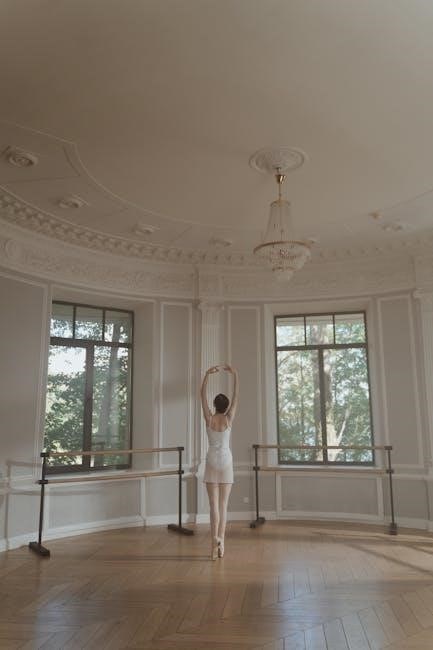Angela Carter’s The Bloody Chamber and Other Stories is a mesmerizing collection of dark‚ sensual fairy tales‚ reimagining classics with a feminist twist. Published by Penguin and Vintage‚ it explores themes of gender‚ power‚ and desire‚ captivating readers with its vivid storytelling and lyrical prose.
1.1. Overview of Angela Carter and Her Work
Angela Carter was a British novelist‚ short story writer‚ journalist‚ and essayist known for her provocative and imaginative storytelling. Born in 1940 and passing in 1992‚ Carter redefined traditional narratives‚ blending fairy tales‚ mythology‚ and feminism. Her work often explored themes of gender‚ power‚ and identity‚ challenging societal norms. The Bloody Chamber and Other Stories showcases her mastery of reimagining classic tales with a dark‚ sensual‚ and subversive edge‚ cementing her legacy as a literary innovator.
The Bloody Chamber and Other Stories is a captivating collection of short stories by Angela Carter‚ first published in 1979. This anthology masterfully reimagines classic fairy tales such as “Bluebeard‚” “Beauty and the Beast‚” and “Puss in Boots‚” infusing them with dark‚ sensual‚ and feminist themes. The stories are unified by their exploration of power dynamics‚ gender roles‚ and eroticism‚ offering a fresh‚ subversive perspective on traditional narratives. The collection has been widely praised for its lyrical prose and bold storytelling.
Key Themes in The Bloody Chamber
The collection explores power dynamics‚ gender roles‚ and sensuality‚ blending dark fantasy with feminist critique. Eroticism and transformation are central‚ challenging traditional narratives and societal norms.
2;1. Feminism and Gender Roles
Angela Carter’s The Bloody Chamber masterfully subverts traditional gender roles‚ presenting women as empowered agents rather than passive victims. Drawing from fairy tale archetypes‚ Carter reimagines female characters as complex‚ multidimensional figures who challenge patriarchal norms. The stories critique the objectification of women and explore themes of autonomy‚ power‚ and identity. By reworking classic narratives‚ Carter underscores the societal constraints placed on women‚ offering a feminist lens that celebrates female agency and resilience in the face of oppressive structures.
2.2. Reimagining Fairy Tales
Angela Carter’s The Bloody Chamber reimagines classic fairy tales with dark‚ sensual‚ and subversive twists‚ transforming familiar narratives into rich‚ complex explorations of power and identity. Drawing from tales like Red Riding Hood and Beauty and the Beast‚ Carter infuses them with overt sexuality‚ moral ambiguity‚ and feminist critique. Her stories are both fantastical and grounded‚ blending fantasy with stark reality to create vivid‚ thought-provoking narratives that challenge traditional notions of heroism‚ morality‚ and romance‚ offering a fresh‚ provocative perspective on timeless myths.
2.3. Eroticism and Sensuality
Angela Carter’s The Bloody Chamber is infused with a bold exploration of eroticism and sensuality‚ where desire becomes a powerful narrative device. Her stories often feature vivid‚ unapologetic depictions of sexuality‚ challenging traditional notions of modesty and gender roles. Through lush‚ evocative prose‚ Carter subverts the innocence of fairy tales‚ transforming them into dark‚ seductive explorations of human passion. Sensuality is both a tool for empowerment and a source of danger‚ blurring the lines between pleasure and peril in her rich‚ provocative narratives.

Story Analysis: The Bloody Chamber
The Bloody Chamber follows a young bride’s eerie journey to her husband’s ancestral castle‚ uncovering dark secrets and forbidden desires. Carter masterfully blends fairy tale elements with feminist critique‚ exploring themes of innocence‚ power‚ and danger through vivid‚ unsettling imagery.
3.1. Plot Summary
The Bloody Chamber tells the story of a young bride who marries a mysterious‚ wealthy older man. After their wedding‚ she moves to his remote ancestral castle‚ where she uncovers dark secrets about his past. Isolated and uneasy‚ she discovers tragic remnants of his previous wives‚ hinting at a sinister fate. The story reaches a climactic confrontation‚ blending elements of horror‚ suspense‚ and feminist critique‚ as the bride confronts her husband’s true nature and the eerie‚ oppressive world he has created.
3.2. Symbolism and Motifs
In The Bloody Chamber‚ Angela Carter employs rich symbolism to explore themes of power‚ identity‚ and sexuality. Blood symbolizes innocence‚ violence‚ and transformation‚ while the castle represents isolation and patriarchal control. The mirror serves as a metaphor for vanity and self-discovery‚ reflecting the protagonist’s growing awareness of her husband’s true nature. Marriage itself is a motif‚ symbolizing both societal expectations and personal entrapment. These elements weave together to create a dark‚ layered narrative that critiques traditional gender roles and fairy tale tropes.

Story Analysis: The Courtship of Mr. Lyon
A dark‚ sensual retelling of Beauty and the Beast‚ exploring themes of power dynamics and transformation. Mr. Lyon’s mysterious nature and the heroine’s journey.
4.1. Plot Summary
The Courtship of Mr. Lyon follows a young woman who visits a mysterious millionaire‚ Mr. Lyon‚ at his grand estate. Despite his intimidating presence‚ she feels drawn to him‚ but their relationship is complicated by his enigmatic nature. As their bond deepens‚ she uncovers secrets about his identity and the true cost of their connection‚ leading to a transformative revelation that challenges her perceptions of love‚ power‚ and self-discovery.
4.2. Themes of Love and Transformation
Love in The Courtship of Mr. Lyon is portrayed as a complex interplay of affection and control. The story explores how love can transform individuals‚ often blurring the lines between tenderness and power. The protagonist’s journey reflects a deeper feminist critique of romantic relationships‚ where love is both empowering and suffocating. Carter challenges traditional notions of romance‚ suggesting that true transformation lies in self-discovery rather than dependence on others. This theme resonates with her broader exploration of gender dynamics and personal agency.

Story Analysis: The Tiger’s Bride
Angela Carter’s The Tiger’s Bride is a dark‚ sensual reimagining of a classic fairy tale‚ exploring themes of love‚ power‚ and transformation through rich imagery and symbolism.
5.1. Plot Summary
In The Tiger’s Bride‚ a young woman is gambled away by her father to a mysterious‚ tiger-like aristocrat. She journeys to his castle‚ where she discovers his dark‚ sensual world. Through her experiences‚ Carter crafts a tale of transformation‚ exploring themes of power‚ identity‚ and self-discovery‚ blending elements of fairy tale and gothic horror with rich‚ evocative imagery.
5.2. Exploration of Power Dynamics
In The Tiger’s Bride‚ Carter masterfully explores power dynamics through the relationship between the protagonist and the enigmatic tiger-like aristocrat. The story delves into themes of control‚ submission‚ and transformation‚ questioning traditional hierarchies. The tiger’s dominance contrasts with the young woman’s growing self-awareness‚ symbolizing the shift from oppression to empowerment. Carter’s vivid imagery and sensual undertones highlight the intricate dance of power‚ challenging conventional notions of gender and authority in a rich‚ gothic-inspired narrative.

Cultural and Historical Context
Rooted in traditional fairy tale motifs and historical folklore‚ Carter’s stories reinterpret classic narratives through a modern lens‚ blending cultural richness with provocative reinterpretation.
6.1. Influence of Fairy Tale Traditions
Angela Carter’s The Bloody Chamber and Other Stories draws heavily from classic fairy tale traditions‚ reimagining narratives like Red Riding Hood‚ Bluebeard‚ and Beauty and the Beast. These stories are infused with dark‚ sensual‚ and fantastical elements‚ blending horror and desire. Carter’s reinterpretations challenge traditional norms‚ offering feminist twists that explore themes of power‚ gender‚ and identity. By subverting familiar tales‚ she creates a unique narrative voice that honors folklore while critiquing its historical and cultural underpinnings‚ blending the timeless with the contemporary.
6.2. Historical Background of the Stories
First published in the late 20th century‚ The Bloody Chamber and Other Stories reflects the cultural and feminist movements of the 1970s. Drawing from European folklore and fairy tale traditions‚ Carter’s stories are deeply rooted in historical narratives while offering a modern‚ subversive perspective. The collection captures the essence of Victorian Gothic and medieval themes‚ blending them with contemporary sensibilities. By reimagining classic tales‚ Carter critiques patriarchal norms and explores themes of power‚ desire‚ and transformation‚ making her work a landmark of postmodern literature.
Critical Reception and Legacy
Angela Carter’s The Bloody Chamber and Other Stories is celebrated as a landmark of feminist literature‚ blending dark fantasy with sharp social critique‚ redefining storytelling.
7.1. Initial Reception
Upon its release‚ The Bloody Chamber and Other Stories garnered significant attention for its bold feminist reinterpretation of classic fairy tales. Critics praised Carter’s vivid‚ sensual prose and her ability to weave dark‚ subversive narratives. The collection was celebrated for its originality and intellectual depth‚ though some reviewers found its overt eroticism and violence provocative. The book quickly became a landmark of contemporary feminist literature‚ earning Carter acclaim as a masterful storyteller and cultural critic. Its initial reception marked the beginning of its enduring legacy.
7.2. Lasting Impact on Literature
Angela Carter’s The Bloody Chamber and Other Stories has left an indelible mark on feminist literature and magical realism. Its subversive reimagining of fairy tales inspired countless authors‚ reshaping how traditional narratives are perceived. The collection’s exploration of power dynamics and gender roles remains a cornerstone of academic study. Carter’s work continues to influence writers and scholars‚ cementing her legacy as a pioneering voice in contemporary literature. Her stories’ dark sensuality and intellectual depth ensure their enduring relevance and appeal.
Educational and Academic Relevance
Angela Carter’s The Bloody Chamber and Other Stories is widely studied in universities for its feminist and cultural critiques. Its exploration of power dynamics and gender roles makes it a valuable text for scholars analyzing contemporary literature and gender studies.
8.1. Use in Curriculum
Angela Carter’s The Bloody Chamber and Other Stories is widely incorporated into university syllabi for its rich thematic depth and feminist critique. It is often taught in courses on contemporary literature‚ gender studies‚ and fairy tale adaptations‚ offering students a lens to explore power dynamics‚ gender roles‚ and sexuality. The collection’s complex narratives encourage critical thinking and analysis‚ making it a valuable resource for developing analytical skills. Its inclusion in academic curricula highlights its significance in understanding feminist theory and narrative techniques.
8.2. Scholarly Analysis and Interpretations
The Bloody Chamber and Other Stories has been subject to extensive scholarly analysis‚ focusing on its feminist and cultural critiques. Scholars like Renfroe and Katsavos explore themes of power dynamics‚ gender roles‚ and the subversion of traditional fairy tale narratives. The collection is praised for its intricate symbolism and its challenge to patriarchal structures‚ offering a nuanced exploration of female agency and desire. Academic interpretations often highlight Carter’s ability to blend the fantastical with the political‚ making her work a cornerstone of feminist literary studies and cultural theory.